 |
Mary's Rosaries |
| Home
Page Contact Us Make a Payment, Methods of Payment, Refund and Exchange Policies Rosaries subpages: How to Pray the Rosary subpages:
Pictures Main Page subpages: Curriculum subpages: Website Terms of Use License Agreement Sitemap The Work of God's Children |
North Korea
 An independent kingdom for
much of its long history, Korea was occupied by Japan in 1905 following
the Russo-Japanese War. Five years later, Japan formally annexed the
entire peninsula. Following World War II, Korea was split with the
northern half coming under Soviet-sponsored Communist domination. After
failing in the Korean War (1950-53) to conquer the US-backed Republic
of Korea (ROK) in the southern portion by force, North Korea (DPRK),
under its founder President Kim Il Sung, adopted a policy of ostensible
diplomatic and economic "self-reliance" as a check against excessive
Soviet or Communist Chinese influence. The DPRK demonized the US as the
ultimate threat to its social system through state-funded propaganda,
and molded political, economic, and military policies around the core
ideological objective of eventual unification of Korea under
Pyongyang's control. Kim's son, the current ruler Kim Jong Il, was
officially designated as his father's successor in 1980, assuming a
growing political and managerial role until the elder Kim's death in
1994. After decades of economic mismanagement and resource
misallocation, the DPRK since the mid-1990s has relied heavily on
international aid to feed its population while continuing to expend
resources to maintain an army of approximately 1 million. North Korea's
history of regional military provocations, proliferation of
military-related items, and long-range missile development - as well as
its nuclear, chemical, and biological weapons programs and massive
conventional armed forces - are of major concern to the international
community. In December 2002, following revelations that the DPRK was
pursuing a nuclear weapons program based on enriched uranium in
violation of a 1994 agreement with the US to freeze and ultimately
dismantle its existing plutonium-based program, North Korea expelled
monitors from the International Atomic Energy Agency (IAEA). In January
2003, it declared its withdrawal from the international
Non-Proliferation Treaty. In mid-2003 Pyongyang announced it had
completed the reprocessing of spent nuclear fuel rods (to extract
weapons-grade plutonium) and was developing a "nuclear deterrent."
Beginning in August 2003, North Korea, China, Japan, Russia, South
Korea, and the US have participated in the Six-Party Talks aimed at
resolving the stalemate over the DPRK's nuclear programs. North Korea
pulled out of the talks in November 2005. It test-fired ballistic
missiles in July 2006 and conducted a nuclear test in October 2006.
North Korea returned to the Six-Party Talks in December 2006 and
subsequently signed two agreements on denuclearization. The Initial
Actions Agreement of February 13, 2007 shut down the North's nuclear
facilities at Yongbyon in July of 2007. In the Second Phase Actions
Agreement of October 3, 2007, Pyongyang pledged to disable those
facilities and provide a correct and complete declaration of its
nuclear programs. Korean is spoken.
|
A "Safe for Souls" webpage. (this is the bottom of page) |